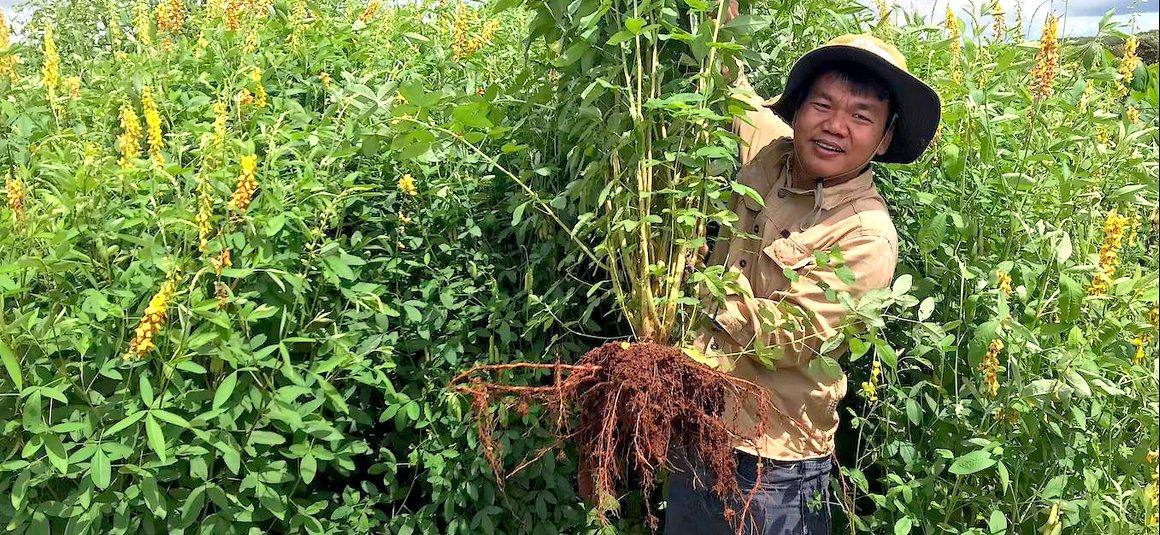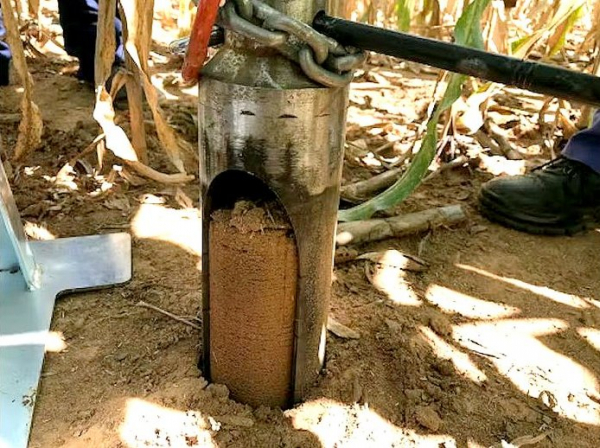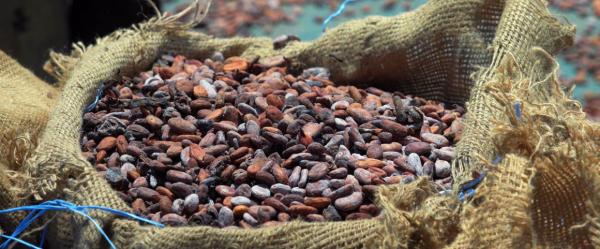Expert view 30 September 2025
- Home
- CIRAD news
- News
- Sequestering carbon in soils through agriculture
Sequestering carbon in soils: what agriculture can do

The soil contains three times more carbon than the atmosphere © CIRAD, R. Cardinael
In our everyday lives, we barely notice it, yet it is nothing less than the largest stock of carbon in terrestrial ecosystems. This distinction goes not to forests or to the atmosphere, but to soils. There are around 2 400 billion tonnes of carbon in the top two metres of soil, which is three times more than the carbon found in the atmosphere.
In the context of climate change and the urgent need to reduce greenhouse gas emissions, the impressive capacity of soils to store carbon deserves special attention. Soils alone clearly cannot dramatically reduce the atmospheric greenhouse gas concentrations responsible for global warming. But they can play a vital role, through efforts to preserve the huge carbon stocks found below ground, but also to restore degraded lands, in particular through specific agricultural practices that enable more carbon to be sequestered by soils.
How carbon enters the soil
It all begins with photosynthesis, during which plants fix atmospheric carbon dioxide (CO2) in chloroplasts, which are small, high-chlorophyll cell organelles. This CO2 is associated with molecules of water (H20) through solar energy, and thus produces glucose (carbon-rich molecules) and oxygen (O2). Some of this carbon captured by the plant enters the soil directly through the roots, by root exudation or the renewal of fine roots.
Carbon can also enter the soil when dead leaves fall from plants or when crop residues are left on fields. When they fall, these high-carbon leaves cover the soil, decompose, are ingested by bacteria, fungi and earthworms, and are ultimately transformed into soil organic matter. Some animals can also accelerate the process of transferring carbon to the soil, such as fungus-growing termites, which transport plant residues to their mounds, where symbiosis with fungi makes them more digestible for the termites.
Some regions and ecosystems contain very high soil carbon stocks. This is the case, for example, of the boreal regions, where huge stocks are preserved in the permafrost, but are currently threatened by global warming. In the tropical regions, the high productivity of ecosystems, especially forests, along with very deep soils, also explain the high stocks observed.
The main challenge facing all of these carbon-rich ecosystems, including forests, wetlands, mangroves and permanent grasslands, is more to preserve these stocks than to increase them, since this carbon is considered to be irrecoverable on a human scale. This means halting deforestation and ecosystem conversion to cropland. On average, 25% of soil carbon is lost when forests or wetlands are converted to cropland, and sometimes more. In agricultural land, certain practices enable additional carbon to be sequestered by soils. Ensuring their widespread implementation is one of the objectives of the “4 per 1000” initiative launched at COP21.
Which agricultural practices increase soil carbon stocks?
Numerous practices help to increase carbon stocks in agricultural soils, including agroforestry, cover crops and organic amendments. Three solutions are regularly proposed. The first is no-tillage or reduced tillage farming. This technique consists in sowing crops without tilling or ploughing the entire field beforehand. This practice helps to reduce soil erosion, to slow the decomposition of organic matter through less-oxygenated soils, and to preserve soil biodiversity (especially earthworms).
The second practice recommended is maintaining permanent soil cover, either by applying crop residue mulch to fields, or by growing live cover plants between the different crops. This cover protects soils from erosion, especially by water, and helps to fix carbon while benefiting soil fauna (bacteria, fungi, earthworms, etc.).
The third technique put forward is crop diversification, either with crop rotation or intercropping. This diversification helps to limit the development of plant pests and diseases, but also increases cropland productivity, especially through the previous effects of crops. For example, a legume (pea, bean, groundnut, faba bean, alfalfa, etc.) in the rotation will fix atmospheric nitrogen and add it to the soil for the following crop, thereby fostering its growth. Better crop productivity means more carbon is fixed in the plot, and more carbon therefore enters the soil, especially through crop roots.
These three practices correspond to the three pillars of what is known as “conservation agriculture”. These practices become truly effective in terms of increasing soil carbon when they are associated. If implemented separately, they may have little or no impact. This is the case of no-tillage alone, which can have a positive effect on soil carbon in certain contexts but not in others. The scientific community was slow to realise this, as research initially focused on the first few centimetres of soil depth, which, under the effect of no-tillage, did have a higher carbon content.
But this was sometimes accompanied by a reduction in soil carbon in the deeper soil layers in relation to systems with tillage, in which soil carbon was homogenised over 20 or 30 centimetres of soil depth. In some cases, no-tillage therefore has an effect on the redistribution of carbon in the soil profile, without necessarily producing a net increase in overall stocks, which is vital for climate change mitigation. A recent summary of research conducted in sub-Saharan Africa suggests that only combining the three pillars of conservation agriculture will significantly increase soil carbon stocks, and that reduced tillage alone is ineffective.
What are the results in Zimbabwe and Cambodia?
To fully understand the benefits of these three practices when they are associated, it is crucial that experiments are conducted over the long term. In fact, it takes an average of 5 to 10 years for a variation in the soil carbon stock to be detected significantly.
In Cambodia, CIRAD and the Cambodian Ministry of Agriculture launched experiments 14 years ago in systems based on cassava, a crop that covers almost 700 000 hectares in the country and is mainly destined for export, to produce flour for animal feed.
By combining no-tillage and direct sowing, permanent soil cover with cover crops, and crop rotation with maize, we noted a considerable increase in soil carbon, with carbon accumulation rates in the order of 0.7 to 0.8 tonnes of carbon per hectare per year to 40 centimetres of soil depth. The hot, humid climate in the region is suited to permanent soil cover with very productive cover crops, including legumes (crotalaria, cowpea) and grasses (millet) between cassava and maize crops, over which the maize is sown.
This process means that carbon is fixed all year round by photosynthesis, and a very deep root system develops, thereby increasing carbon stocks below the top soil layers. This additional soil carbon storage will continue until a new system balance is reached. This experiment is intended to be long-term in order to determine for how many decades such a system will store carbon. Once the balance is reached, the goal will be to preserve these carbon stocks by maintaining good soil management practices. Effectively managing soils implies long-term rather than ad hoc management.
In Zimbabwe, in a totally different context, with a dry season lasting seven months and a rainy season of five months, we also wanted to measure the effectiveness of these combined practices over the long term. To do so, we have an experiment set up 10 years ago by our colleagues from the International Maize and Wheat Improvement Center in a low-input system with maize as the main crop. We have been able to measure soil carbon stocks under the different practices, either separately or combined: fields with tillage, fields with no-tillage, with or without maize crop residues (mulch), and with or without rotation with cowpea, a legume.
Once again, the results show that no-tillage alone achieves little, and even leads to a slight loss of soil carbon in relation to tillage. This is explained at this site by the fact that soil is more compacted in no-tillage systems, meaning roots struggle to develop. In addition, there is less rainwater infiltration and more runoff, resulting in water stress for maize. Ultimately, maize develops far less in these systems and the roots therefore add less carbon to the soil, which translates into a loss of soil carbon.
On the other hand, fields with no-tillage, but with mulching of maize crop residues from the previous season and crop rotation see an increase in carbon stocks with, however, an effect limited to the topsoil. We nevertheless note a net increase in the carbon stock, since no deep carbon loss is observed.
What are the obstacles to the development of these practices?
Although these results are promising, such practices are not always easy to implement. In Zimbabwe, for example, a major constraint has emerged. Agricultural systems there are low-input mixed crop-livestock systems (little mineral fertilisation, little or no mechanisation). At harvesting, only maize cobs are gathered, by hand, and the stalks are left standing in fields. These will serve as feed for livestock during the dry season, when cattle graze directly on the fields after having roamed in forests and communal areas during the rainy season.
There is thus competition for the use of maize residues, for either livestock feed or soil cover. Some farmers install fences to prevent livestock from eating crop residues during the dry season, which has a cost. Others harvest residues and store them up high, away from livestock, and apply the mulch just before the rainy season. This implies careful organisation, and extra time and energy. In both cases, an alternative source of livestock feed also has to be found.
In these places, as in others, the value of these practices for farmers does not therefore lie in soil carbon sequestration and its impact on climate change mitigation. These techniques are generally adopted for their positive impact on soil fertility and the resulting crop productivity, by reducing the risk of erosion and increasing the availability of nutrients, but also by helping to adapt to climate change through, for example, improved water conservation. These benefits are crucial and are very often a priority for farmers in the global South, who are among the most severely impacted by climate change.

























 appliqués à la surface après la récolte. Rémi Cardinael.JPG)



